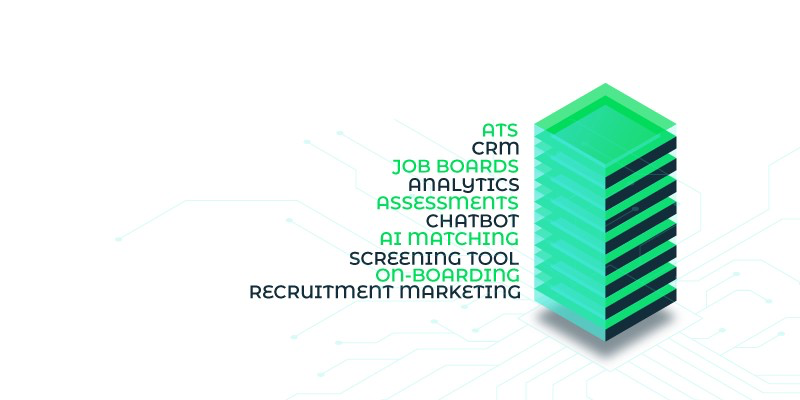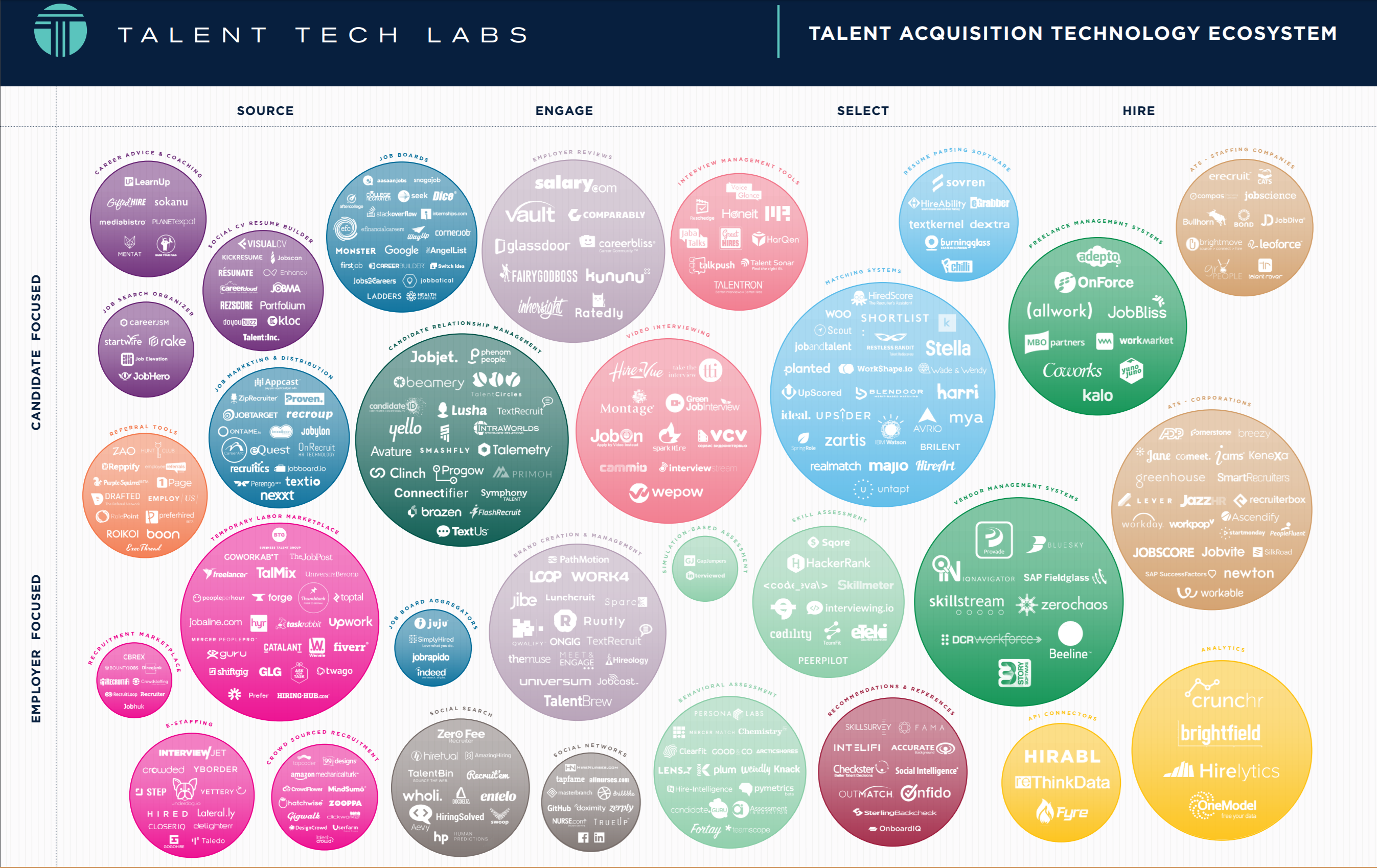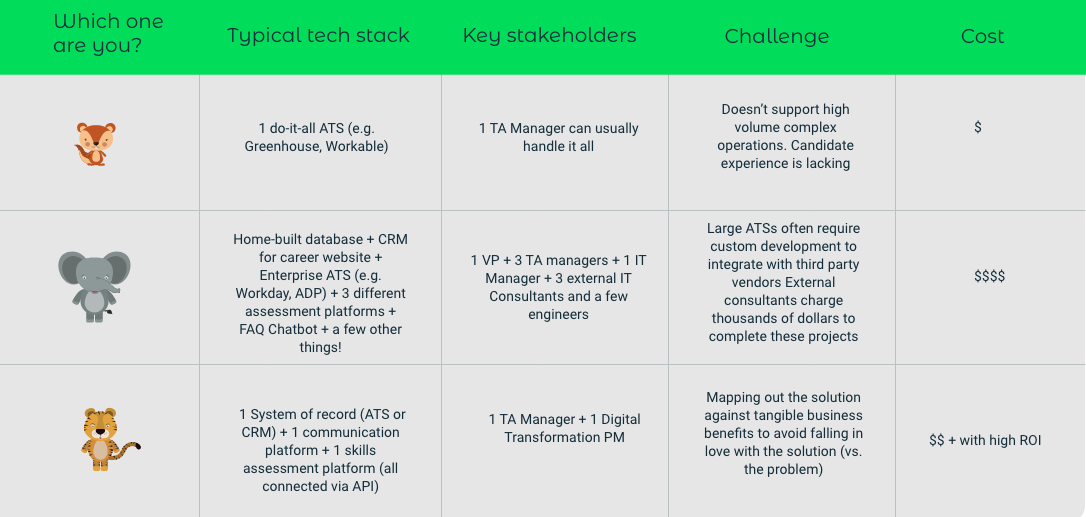Maybe. Adding another technology to your digital recruiting arsenal means integration work and potential overlaps. How to decide when enough (tech) is enough?

The recruiting industry has been making an effort to become more candidate-centric, and in turn digital solutions have been cropping up to help bridge the gap between traditional recruiting and modern marketing. The leading vendors of Applicant Tracking System (ATS) are now almost 20 years old, and some have struggled to keep up with the times, notably they were designed in an age that preceded high volume inbound marketing campaigns, as well as messaging communications. In fact, most ATSs were designed before Apple designed phones! It is no surprise therefore that most of those systems need to be augmented/enhanced with third party solutions, notably for anything related to candidate experience.
One Size Does Not Fit All
For most TA managers, adding another technology to their existing tech stack may not come naturally. Wouldn’t it be nice if they could get everything from one vendor? Wouldn’t it be lovely if the recruiters could continue to use the same tool year after year, without having to re-invent their processes? Yes, it would, but given the pace at which behaviors are changing among candidates, recruiters will need to continuously adapt their tech stack and find innovative ways to connect with talent.
For example, even though 40% of companies are using AI in their business processes, this technology is already falling short in Talent Acquisition. Recruiters simply can’t rely on a machine to interpret human interactions. They can however rely on automation of repetitive tasks, thus the trend is shifting towards RPA (Robotic Process Automation). But, they still need AI, it’s the foundation upon which automation is built.
In other words, the technology each Talent Acquisition team will need to handle is only going to get higher, or at the very least change… You might as well embrace the challenge.
An Ever-Increasing Tech Stack

Integrations can help you build a solid tech stack, which should include solutions in each of these areas:
- Job Advertising
- Sourcing
- Selection (Assessments)
- Onboarding
Plus, the backbone that ties it all together, a CRM or an ATS.
The good news: most tech vendors have become adept at working with a complex tech stack, where they have to co-exist and collaborate with other systems with open APIs. Smartly integrated, one tool can help you connect to the ones you’re already using and boost their performance.
Most employers handling large volumes of data rely on dozens of such integrations, making sure those systems are communicating via automated workflows. For large companies to stay competitive, this level of automation is a pre-requisite. Such is the case for iQor Philippines, a managed services provider of customer engagement and technology-enabled BPO solutions, with a presence in more than 7 locations.
“We prefer to work with vendors with an expanded API, which allows us to manage recruitment campaigns with all the data being centralized. This integration makes the process easier for our recruiters, reducing the amount of data entry considerably.” — Cynthia Maslian, Director of Talent Acquisition
The Adecco Group, also values customization and integration. So much so, that they have created The Digital Factory, a R&D lab both to handle third party vendor evaluation and do greenfield research.
“Any tool we take on needs to be customizable, we should be autonomous to work on the product. We really want to kind of dive into the product and have people working on it.” — Alice Depierre, Business Analyst, Adecco Digital Factory
What to Look For, What to Avoid
Slow response times… Lack of status updates… The right tech stack can address these recurring pain points, and many others. Google, Facebook, Microsoft and Indeed are now all major players in the recruitment space, and making it easier than ever for job seekers to connect with employers. In this context, candidate volumes will continue to grow and employers will have to deal with an increasing volume of data.
Hence, tools that automate top-of-funnel tasks, support interactive applications with rich media, offer digital agents that answer questions 24/7, as well as keep them informed every time an action is taken with their application will be the only way for employers to continue delivering a good candidate experience.
But it’s easy to get caught up in the novelty of it all and lose sight of why tech implementation is beneficial in the first place. Before adopting a new solution look at other teams inside your own company. What you need might already exist in another department.
As Depierre points out, “We have seen in the past few years that by trying to have new tools we’re basically multiplying them. This is something we should avoid. It’s time consuming and inefficient.”
One way to ensure technology and business alignment is by hiring an expert. The Adecco Group has positions such as “Digital Transformation Lead.” This person is an in-house consultant of sorts, who makes the connection between IT and business. According to Depierre,“They are the ones who explain this is what our users need and this is what we will be offering thanks to the vendor. They also outline if and how we need to adapt.”
Tech Stack Archetypes

Lean and Mean
These companies have opted for a simple model, using an ATS like Greenhouse or Workable, they have one career website and that’s pretty much it. Implementation is fairly straightforward, you don’t need a fancy job title to serve as a link between IT and business, you don’t even really need IT. So it’s easy to do, and doesn’t cost much at all. But, it comes with its downsides. An ATS allows for a very low level of automation, leaving recruiters to spend their time sifting through resumes or trying to schedule interviews, instead of connecting with prospects.
Plus, it doesn’t adapt to different geographies and their local needs. The candidate experience is lacking, forcing talent to apply by filling out forms that live in one location, and receiving any type of response can take a long time. It doesn’t source candidates where they are, it adds extra steps, like filling out information which is already covered on their resumes or reformatting it to feed into the company’s ATS.
LinkedIn reports that companies lose out on 60% of applicants “if they encountered tech hurdles”, 55% “if they couldn’t upload their résumé ”, 44% “if they couldn’t follow up on the application’s status”, and 20% “if they “couldn’t complete the application on a mobile device.” In short, this tech stack isn’t built to perform high volume complex operations.
High Complexity
This tech stack relies heavily on a highly specialized IT department. It includes dozens of tools that are supposed to be working together, but more often than not, at least one or several isn’t working properly. Companies using these have teams of tech experts, as well as teams that serve as tech translators to the business departments. They are constantly making connections and reframing complicated backend processes, while recruiters can get frustrated if functions keep on changing or aren’t clear to begin with. It’s costly — not only the tools themselves, but the teams needed to make them work.
On the other hand, top industry leaders see this challenge and are trying to solve it. The more specialized you want to get, the more tools you’ll need — but your team doesn’t need to see them, just use them. This tech stack is the future, but we haven’t gotten effectively there yet.
Smartly Integrated
In the meantime, there’s nothing wrong with aspiring to a lean(er) stack, sometimes a combination of tools, say having one for sourcing, and another for candidate screening, isn’t necessary.
The smartly integrated tech stack works with your ATS as the backbone, and maybe four or five additional tools that perform specialized activities. For example, if you’re seeking video assessments, language analytics, or social media sourcing (leading ATSs are notoriously poor at social media integration).
It’s efficient because it doesn’t rely upon dozens of digital solutions working at once — which most of the time half of them aren’t, but it covers the expanse of what your recruiting team needs. IT gets involved in the beginning, making the necessary connections, but your recruiters don’t even need to know it. Once it’s up and running, what’s going on the backend isn’t their problem, ideally they won’t even have to switch platforms. They can perform all their necessary activities in one space, using all the technology at their disposal.
Three rules to follow when choose a new digital tool:
1. Research: talk to existing customers to find out if the promises has been delivered for them.
2. Alignment: map out if the new tech overlaps with you existing stack, and if it may complement or enhance it.
3. Adoption: Easy to integrate? Look for vendors with open API and plenty of documentation to facilitate painless (=cheap) integrations
The Talkpush Vision is APIdaptable
With this in mind, we’ve shaped Talkpush over the years to excel at wide scope of activities inside a narrow function: performing top-of-funnel recruitment tasks. Our platform takes care of capturing leads, engaging them through messaging, keeping them informed regarding actions taken with their application, and automatically scheduling interviews with pre-qualified talent, as well as tracking a variety of data points so that recruiters can investigate hiring rates for each subcategory and improve upon their approach.
We’ve also left plenty of room for customization. An open API allows our customers to integrate our technology into their processes, and build up their tech stack as painlessly as possible.
So, here we are. TA tech stacks will definitely keep on growing in number of tools and complexity. It’s up to HR managers to start building strong foundations that meet their needs today, without rendering their processes inefficient, but ensuring they will be able to expand and adapt tomorrow.
Talkpush is the new way employers and candidates connect all over the world. We believe hiring is about starting conversations; and are on a mission to level up the recruitment experience. Want to know more? Schedule a demo 👉👉👉 here.
If you like what you read, share using #Letthetalenttalk or #levelup and don’t be shy with your thumbs up!


